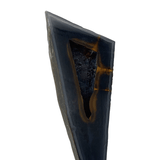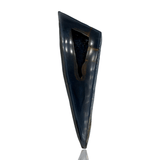2025: We're focusing on our physical store experience. Come see us there! Web sales are paused.
Here is a great example of the extremely sought-after Polyhedral Agate Geode. Specimens such as this one are one of, if not the most, unique agate specimens on the market today. Mineral collectors from all over the world purchase these for their unique geometric formation.
These agates are so special because of their rarity and the process behind their formation. These specimens have only been found in Além Paraíba, Minas Gerais, Brazil, the vast majority of mining taking place in the 1970s. It is theorized these agates formed between intergrown angular crystals of quartz/gypsum. The filling of these cavities with element-rich waters would cause the geometric formation opposed to the normal "bubble" geode.
Agate is a combination of chalcedony and quartz. It is easily recognizable by its multitude of colors and banding. Some of the most common formations of agates occur in geodes. These are cavities of gas that are eventually filled with fluids high in silica, allowing the formation of agate to take place. These geodes are then cut and polished to show their banding and crystals within them to be put on display. Agates have been used for decorative purposes as far back as 5000 years ago. Agate specimens are commonly dyed unnatural colors such as blue, purple, and pink to help showcase their banding.
Size: 3.2 x 1.1 x 0.6 in.
Weight: 1.45 oz
You will receive the specimen pictured. Colors may vary based on screen size and resolution.
Note: Our online store is paused while we focus on our physical store.



